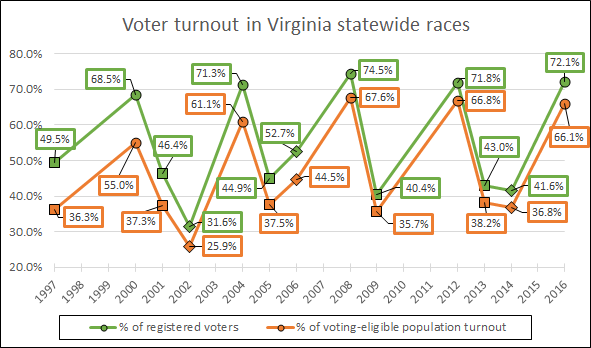Despite having the blessing of Gov. Terry McAuliffe and an unpopular president weighing on his GOP challenger, Lt. Gov. Ralph Northam’s 2017 gubernatorial campaign is being warned about a November “surprise” that could deliver a stunning defeat and potential blow to McAuliffe’s 2020 bid.
The hometown political guru, the University of Virginia’s Center for Politics ‘Crystal Ball,’ said that GOP challenger Ed Gillespie could be that surprise.

Noting questionable polling, Northam’s lackluster support and past gubernatorial campaigns showing a late conservative surge, the Center’s Geoffrey Skelley wrote in the Crystal Ball, “While it’s true that Virginia polls were relatively on the mark in 2016, if Northam isn’t consistently hitting 50 percent in some polls heading into Election Day 2017, he will have good reason to fear a surprise.”
He gives all the details, fact and figures, but the takeaway is that Northam isn’t seeing a bigger advantage from McAuliffe’s popularity and Trump’s unpopularity. And, he added, Virginia polls seem to have a record of under counting conservatives.
Currently, Northam edges Gillespie in the polls, but one internal Northam report cited by the Daily Beast said the gap is within the polling margin of error.
Skelley wrote, “The favorable environment — that is, a fairly unpopular Republican president in the White House and a relatively popular outgoing Democratic governor — is helping to keep the Democrat slightly ahead, but given the tendency in Virginia to vote against the sitting presidential party in gubernatorial elections and Trump’s poor approval rating, Northam should maybe be ahead by a little more.”
He also drew up this paragraph of concern about Northam’s polling and the state’s polling record:
A concern for the Northam campaign has to be the recent history of polling in Virginia and nationally that has missed some conservative voters. For example, the final RealClearPolitics average in 2013 showed McAuliffe leading Ken Cuccinelli (R) 45.6%-38.9%, with Libertarian Robert Sarvis getting 9.6%. Although McAuliffe led by 6.7 points, he only won by 2.5 on Election Day, 47.7%-45.2%. Some of that was Sarvis’ slide to 6.5%, as it’s likely that some Republican voters considering Sarvis came home to the GOP in the end (some of Sarvis’ purported voters probably failed to show on Election Day, too). In 2017, there’s also a Libertarian candidate, Cliff Hyra, though he looks set to win a far smaller share of the vote than Sarvis did. Nevertheless, Cuccinelli’s actual percentage was 6.3 points higher than his polling average while McAuliffe’s was only 2.1 points higher. We’ve seen this phenomenon in recent races, most notably some swing states in the 2016 presidential race, but also in contests like the 2015 Kentucky gubernatorial election. What Northam has to hope for is that with a different party holding the White House, the polls are either on the mark or they underestimate Democrats, not Republicans.
Paul Bedard, the Washington Examiner’s “Washington Secrets” columnist, can be contacted at [email protected]

